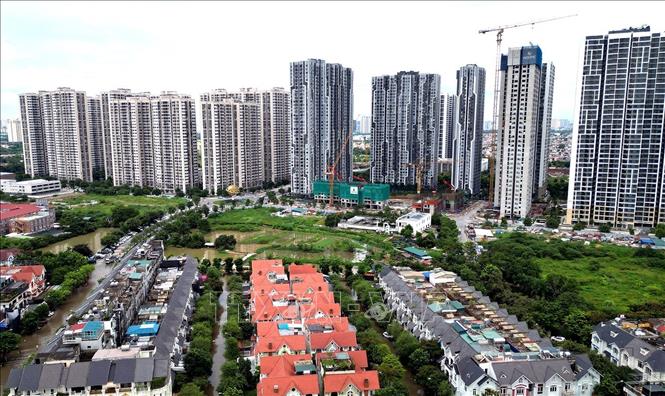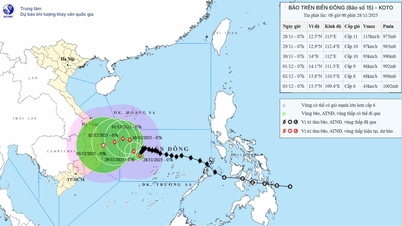
Reducing housing prices is becoming an urgent need as the price level continues to climb, far beyond the affordability of the majority of people. However, this problem is not simple when the gap between “paper” and actual costs is still large. In addition, localities are preparing to issue a 2026 land price list with a strong upward trend. The risk of a new “wave” of price increases makes the goal of reducing housing prices even more distant. Experts generally agree that to reduce housing prices, intervention from the root is the “key”.
Pressure from rising land prices and invisible costs
Many real estate businesses reflect that land costs are the heaviest item in the input structure. If the new land price list continues to increase, land use fees, compensation and site clearance costs may increase the total investment to hundreds of billions to thousands of billions of VND. In that context, reducing housing prices is very difficult.
Not only businesses but also people who need to change land use purposes are worried about the sharp increase in financial obligations. If a lower price is proposed, the group whose land is recovered is worried about low compensation and unfairness. Conflicting interests make land costs increasingly difficult to control.
According to the Vietnam Valuation Standards (Circular 42/2024/TT-BTC), the total project development cost includes construction costs, contingencies, business, finance, taxes and investor profits. Compensation and site clearance costs are separated to accurately reflect the input value. However, actual survey data in many localities is still lacking updates, leading to cost calculations based on old norms, which are not close to current material and labor prices.
Director of the Vietnam Real Estate Research Institute (VIRES) Bui Van Doanh commented that the standards are clear and transparent, but the actual implementation has not kept up. This gap makes it difficult to control housing prices effectively.
From a business perspective, Mr. Nguyen Chi Thanh - General Director of Ho Tay International Building Company said that the investment cost of housing projects spans dozens of categories, in which land and legal issues are the two biggest "bottlenecks". Particularly for apartments, land costs often account for 30 - 40% of the total capital; the "cleaner" the land, the higher the price.
Construction accounts for 35-40%, including foundation, body, electrical and mechanical to landscape. However, it is worth mentioning that many “soft” costs such as design, legal, marketing, brokerage commissions… account for 15-20% of the cost but are rarely mentioned.
At the same time, financial costs are also a burden. With a project worth several thousand billion VND, businesses are forced to borrow from banks with interest rates of 12-14%/year. But if the procedures are prolonged for just one more year, the capital costs will increase by hundreds of billions of VND - Mr. Thanh shared.
Therefore, to reduce housing prices, according to experts, the first thing to do is to make all cost components transparent, especially land and administrative procedures. When input costs are clear, the management agency will have a basis to regulate by tax, land price coefficient or credit, instead of applying rigid administrative measures.
Regulate from the root
Mr. Bui Van Doanh said that the State's direct intervention in selling prices is "very difficult and almost impossible". Instead, the State should regulate input costs and apply a tiered tax policy so that businesses can set their own prices.
It is possible to consider a segmented profit tax model. For example, high-end commercial housing is subject to a higher tax rate because it serves the high-income group. Meanwhile, affordable commercial housing and social housing are subject to a lower tax rate to reduce input costs and lower selling prices. This model both creates fairness and forces businesses to optimize costs if they want to compete in the affordable segment - where there is the greatest demand in the market - Mr. Doanh proposed.
In addition, it is necessary to shorten the time for project approval, make material price data transparent and build a preferential credit mechanism for social housing. When businesses reduce land costs, financial costs and procedures, housing prices will automatically decrease without administrative orders.
“The root problem lies in planning and how to determine land prices. If a project is built that local people cannot afford, then the planning is ineffective,” Mr. Nguyen Chi Thanh raised the issue.
Localities need to invest in large-scale urban areas with complete infrastructure on newly developed land to make land costs more reasonable. Currently, there is a common "mistake" of using the high selling prices of previous projects - capital created by big brands - as the basis for calculating land use fees for later projects, causing land prices to be pushed up unrealistically.
To reduce costs, Mr. Thanh also proposed applying standard design modules for large-scale projects, helping to reduce design costs and shorten implementation time. Because when design costs are reduced, businesses can lower prices while still maintaining quality.
Recently, the Draft Resolution on the mechanism to control and curb real estate prices is being solicited for comments; focusing on tightening speculative credit and reviewing land use fees. However, experts assess that this is only a temporary "fever reducer". To reduce housing prices sustainably, the policy must start from the root through regulating the added value of land and reforming the land tax system.
Dr. Thai Quynh Nhu, former Director of the Institute for Land Management Research, said that every time there is public investment, road opening, or planning adjustment, land prices immediately increase sharply, but the State does not collect this increased value. When land prices are "pushed" up by non-investment factors of enterprises, input costs of adjacent projects increase accordingly, causing housing prices to escalate uncontrollably.
Therefore, this expert proposed to separate two types of land rent. The first is the differential land rent created by the State and the community (planning, infrastructure, etc.); the next is the differential land rent due to business investment. The differential land rent created by the State and the community needs to be recovered by the State at a certain rate.
For example, for transport infrastructure projects, the State can collect 40% of the added value; for real estate projects, the collection rate is 50-50 between the State and the investor... Or for industrial projects, the State collects about 30% to encourage investment in production.
This mechanism helps avoid revenue loss, limit land speculation near planning areas and reduce land costs - the factor that accounts for the largest proportion of housing prices. At the same time, it is necessary to build a synchronous land tax system, avoiding "tax on tax" - experts "suggest". Because currently, real estate traders have to bear a series of financial obligations. If new taxes are imposed without stratification, housing prices may... increase further.
Many experts agree that reducing housing prices is not a one-day or two-day affair. Housing prices can only be reduced when the entire ecosystem from planning, administrative procedures, land valuation, taxes to credit operates transparently and consistently.
That means businesses can reduce land costs, capital costs, and time costs. The State can reasonably regulate the increased land value. Speculators no longer have the incentive to “hold land and wait for the right time.” Middle- and low-income people can access affordable housing.
If solutions are deployed synchronously, the dream of home ownership for millions of people will be closer, not by administrative orders but by a transparent and fair market mechanism.
Source: https://baotintuc.vn/bat-dong-san/kho-giam-gia-nha-can-thiep-tu-goc-moi-la-chia-khoa-20251126171735123.htm






![[Photo] President Luong Cuong attends the 50th Anniversary of Laos National Day](/_next/image?url=https%3A%2F%2Fvphoto.vietnam.vn%2Fthumb%2F1200x675%2Fvietnam%2Fresource%2FIMAGE%2F2025%2F11%2F27%2F1764225638930_ndo_br_1-jpg.webp&w=3840&q=75)
![[Photo] Prime Minister Pham Minh Chinh chairs the 15th meeting of the Central Emulation and Reward Council](/_next/image?url=https%3A%2F%2Fvphoto.vietnam.vn%2Fthumb%2F1200x675%2Fvietnam%2Fresource%2FIMAGE%2F2025%2F11%2F27%2F1764245150205_dsc-1922-jpg.webp&w=3840&q=75)







































































































Comment (0)